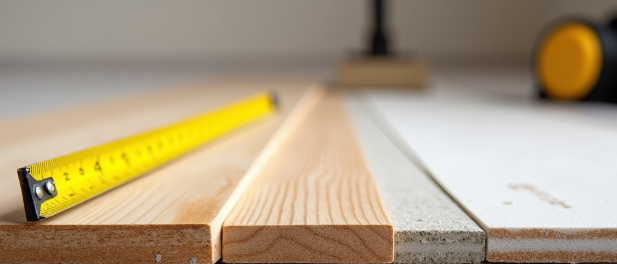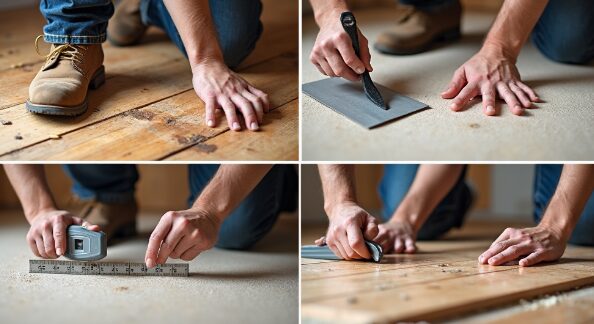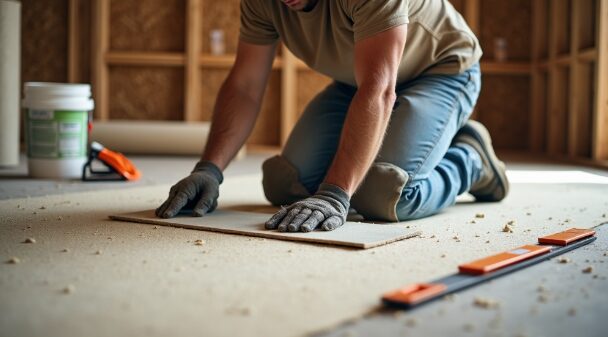Proper subfloor preparation techniques are a crucial first step in any flooring project. A well-prepared subfloor ensures that your new floor not only looks great but also lasts for years to come. Here, you’ll find easy-to-follow methods to get your subfloor ready effectively. For professional assistance and flawless results, rely on expert floor installation services in Vancouver.
Table of Contents
Key Takeaways
- Understanding subfloor types is important for choosing the right prep method.
- Cleanliness is vital. Remove dirt and debris before starting.
- Level the subfloor to avoid bumps and dips in your new floor.
- Install moisture barriers to protect against dampness.
- Choose the right underlayment for sound and insulation benefits.
For more detailed information on different flooring options, consider exploring the guide on choosing the right flooring for your home.
What Is a Subfloor Preparation Techniques?

A subfloor is a layer of material that sits between your floor covering and the floor joists. It provides a flat, stable surface for your final flooring and adds strength and durability to your home. If your subfloor is weak or uneven, it can cause problems like warping, squeaking, or even premature wear on your new floor.
Proper subfloor preparation techniques are essential to avoid these issues and ensure a smooth and long-lasting floor installation. For expert results, consider relying on professional floor installation services in Vancouver.
Types of Subfloor Materials

Common subfloor materials include plywood, oriented strand board (OSB), and concrete, each with its own set of benefits and drawbacks. Plywood is strong and flexible, OSB is cost-effective and durable, and concrete offers excellent stability for areas like basements. Knowing the material of your subfloor is crucial as it helps you choose the best subfloor preparation techniques for the job.
Whether you’re dealing with wood or concrete, understanding your subfloor ensures that the right steps are taken to create a solid foundation for your new floor. For professional guidance and flawless results, consider floor installation services in Vancouver.
Plywood
Plywood is a popular choice. It is strong and lightweight. Plywood subfloors are easy to install and can be used in most homes. However, they can be affected by moisture if not properly sealed.
Oriented Strand Board (OSB)
OSB is made from wood strands glued together. It is an affordable option and is often used in modern homes. While it is strong, OSB can swell if it gets wet, so keeping it dry is crucial.
Concrete
Concrete subfloors are common in basements and slab homes. They are very durable and resistant to pests. However, concrete can crack over time and may require special preparation to ensure proper flooring installation.
How to Prepare Your Subfloor

Step 1: Inspect the Subfloor
Before you do anything, take a good look at your subfloor. Check for any signs of damage like warping or rotting. This step is crucial. If you find any defects, fix them right away. Ignoring them can create big problems later.
Step 2: Clean the Surface
Once you inspect it, make sure your subfloor is clean. Sweep away dust and debris. If there are any sticky spots, use a mild cleaner to remove them. A clean surface helps the flooring materials stick better.
Step 3: Level the Subfloor
After cleaning, check if the subfloor is level. Use a level tool to find low or high spots. If you find any, you can use leveling compounds or sand down high areas. A level surface is key to a smooth floor.
Step 4: Address Moisture Issues
Moisture can damage your new floor. If you suspect moisture, do a simple test. Tape a piece of plastic sheeting to the subfloor for 24 hours. If condensation forms, you need to manage the moisture. This could mean installing a moisture barrier.
What Is a Moisture Barrier?
A moisture barrier is a protective layer that keeps moisture from affecting your flooring. It is usually made of plastic or specialized membranes. Installing this barrier can help protect your floors in the long run.
Step 5: Choose the Right Underlayment
Underlayment is a layer placed between the subfloor and your final floor. It adds cushioning and soundproofing. Different types of underlayment work better with different flooring materials. For example, foam underlayment is great for laminate flooring, while felt is better for hardwood.
Benefits of Using the Right Underlayment
- Noise reduction: Underlayment can significantly reduce sound transmission between floors.
- Insulation: It can provide additional thermal insulation for your home.
- Moisture protection: Some underlayments offer moisture protection, which is essential in humid climates.
Installing Your Moisture Barrier
If your tests show moisture, you’ll want to install a moisture barrier. Here’s how:
- Select your barrier material. Look for a polyethylene sheet or a specific moisture barrier product.
- Cut the size barrier. Leave a few extra inches around the edges.
- Lay it out flat. Make sure there are no wrinkles.
- Seal the edges. Use tape to secure the edges where they meet the walls. This helps keep moisture from seeping in.
Subfloor Preparation Techniques and Moisture Barrier Comparison
| Subfloor Type | Moisture Resistance | Cost | Installation Difficulty |
|---|---|---|---|
| Plywood | Moderate | Medium | Easy |
| OSB | Low | Low | Easy |
| Concrete | High | Medium | Moderate |
Final Touches Before Flooring
After preparing your subfloor, double-check your work. Ensure everything is clean, level, and dry. At this point, you’re ready to move on to laying your flooring!
Common Mistakes to Avoid
When preparing a subfloor, it’s easy to make mistakes. Here are some common ones to watch out for:
Skipping the Inspection
Never skip the inspection step. Small problems can turn into big issues if ignored. Always check for damage before starting.
Overlooking Moisture
Moisture is a silent enemy. Always test for it, especially in basements. Failing to address moisture can ruin your flooring.
Not Using the Right Materials
Using the wrong underlayment or moisture barrier can lead to problems. Always choose products designed for your specific flooring type.
When to Call a Professional
Sometimes, preparing a subfloor can get tricky. If you find major issues or don’t feel confident in your skills, it might be time to call in a professional. They can assess and prepare your subfloor properly.
Why Choose a Professional?
Professionals have experience and tools that can make the job easier and more effective. They can also identify issues you might miss. This can save you time and money in the long run.
For insights on hiring experts for home improvement, check out this resource on professional flooring services.
Local Considerations for Vancouver, WA Residents
Living in Vancouver, WA, means you need to consider the local climate. The area can be wet, especially during winter. Always be aware of moisture when preparing your subfloor. Local weather can significantly affect your flooring, so take the necessary precautions.
Seasonal Changes
Keep in mind that seasonal changes can affect moisture levels in your home. Make sure to regularly check for any signs of dampness throughout the year.
Building Codes
Before starting any project, check local building codes. They may have specific requirements for subfloor preparation. Staying compliant is important for safety and can prevent issues down the road.
Subfloor Preparation Techniques Checklist
| Preparation Task | Description | Importance |
|---|---|---|
| Inspect the subfloor | Check for damage and defects | Prevent future issues |
| Clean the surface | Remove dust and debris | Improves adhesion |
| Level the subfloor | Ensure a flat surface | Ensures smooth flooring |
| Install moisture barrier | Protect against dampness | Enhances longevity |
| Choose right underlayment | Select appropriate material | Improves comfort & insulation |
Conclusion
Preparing your subfloor is an essential step in any flooring project. By following these techniques, you can set the stage for a beautiful and lasting floor. Remember to inspect, clean, and level your subfloor. Don’t forget about moisture concerns and the importance of the right underlayment. With the right preparation, your new flooring will shine for years to come.
FAQs About Subfloor Preparation Techniques
What should I do if my subfloor is damaged?
If you find damage, replace the affected sections. For small issues, you may be able to repair them with a strong adhesive or patching compound.
How can I tell if my subfloor is level?
Use a level tool. Place it in several areas on the subfloor. If it doesn’t rest flat, you may need to address high or low spots.
Do I need a moisture barrier?
If moisture tests show dampness, installing a moisture barrier is wise. This protects your flooring and helps it last longer.
Can I install new flooring over an old subfloor?
It depends on the condition of the old subfloor. If it’s in good shape, you may be able to install new flooring on top. However, always check for moisture and levelness first.
How long does subfloor preparation take?
The time can vary based on the condition of your subfloor and the size of the area. Simple cleanings and inspections can take a few hours. Major repairs may take longer.
With these insights and techniques, you’re well on your way to preparing your subfloor for a stunning new floor. Happy remodeling!
Ready to transform your kitchen or bathroom with beautiful tile flooring? Prestige Construction & Home Remodeling is here to help! Our team of experts is dedicated to delivering high-quality installations that will enhance the look and functionality of your home. Don’t wait—get started on your project today! Contact us at (555) 123-4567 or email us at [email protected] for a free consultation. Let’s make your dream home a reality

